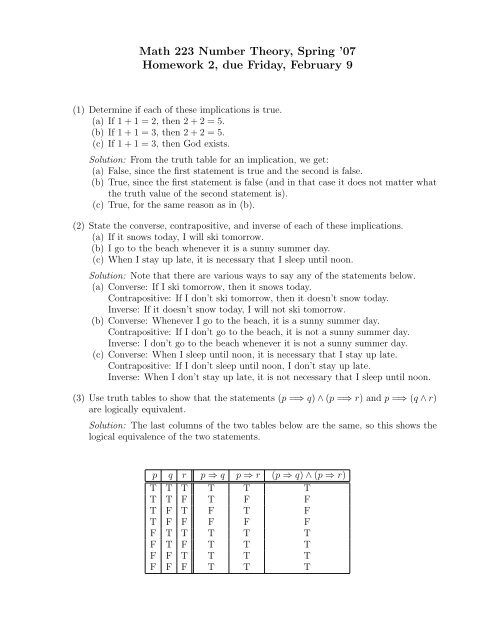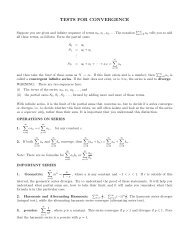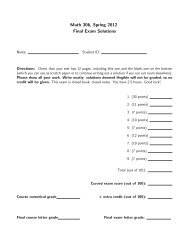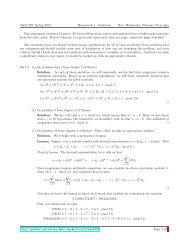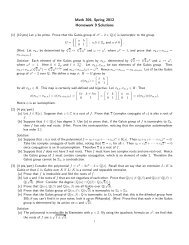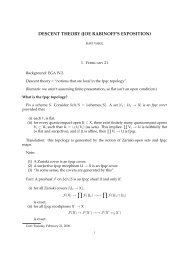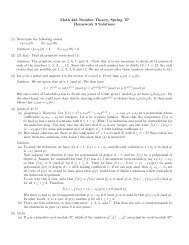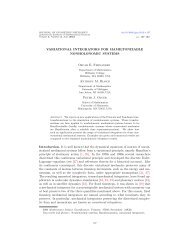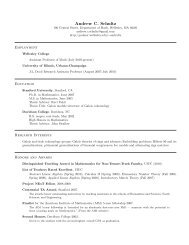Math 223 Number Theory, Spring '07 Homework 2, due Friday ...
Math 223 Number Theory, Spring '07 Homework 2, due Friday ...
Math 223 Number Theory, Spring '07 Homework 2, due Friday ...
Create successful ePaper yourself
Turn your PDF publications into a flip-book with our unique Google optimized e-Paper software.
<strong>Math</strong> <strong>223</strong> <strong>Number</strong> <strong>Theory</strong>, <strong>Spring</strong> ’07<strong>Homework</strong> 2, <strong>due</strong> <strong>Friday</strong>, February 9(1) Determine if each of these implications is true.(a) If 1 + 1 = 2, then 2 + 2 = 5.(b) If 1 + 1 = 3, then 2 + 2 = 5.(c) If 1 + 1 = 3, then God exists.Solution: From the truth table for an implication, we get:(a) False, since the first statement is true and the second is false.(b) True, since the first statement is false (and in that case it does not matter whatthe truth value of the second statement is).(c) True, for the same reason as in (b).(2) State the converse, contrapositive, and inverse of each of these implications.(a) If it snows today, I will ski tomorrow.(b) I go to the beach whenever it is a sunny summer day.(c) When I stay up late, it is necessary that I sleep until noon.Solution: Note that there are various ways to say any of the statements below.(a) Converse: If I ski tomorrow, then it snows today.Contrapositive: If I don’t ski tomorrow, then it doesn’t snow today.Inverse: If it doesn’t snow today, I will not ski tomorrow.(b) Converse: Whenever I go to the beach, it is a sunny summer day.Contrapositive: If I don’t go to the beach, it is not a sunny summer day.Inverse: I don’t go to the beach whenever it is not a sunny summer day.(c) Converse: When I sleep until noon, it is necessary that I stay up late.Contrapositive: If I don’t sleep until noon, I don’t stay up late.Inverse: When I don’t stay up late, it is not necessary that I sleep until noon.(3) Use truth tables to show that the statements (p =⇒ q) ∧ (p =⇒ r) and p =⇒ (q ∧ r)are logically equivalent.Solution: The last columns of the two tables below are the same, so this shows thelogical equivalence of the two statements.p q r p ⇒ q p ⇒ r (p ⇒ q) ∧ (p ⇒ r)T T T T T TT T F T F FT F T F T FT F F F F FF T T T T TF T F T T TF F T T T TF F F T T T
p q r q ∧ r p ⇒ (q ∧ r)T T T T TT T F F FT F T F FT F F F FF T T T TF T F F TF F T F TF F F F T(4) Translate these statements into English, with x and y representing real numbers. Arethe statements true?(a) ∀x∃y (x < y)(b) ∃y∀x (x < y)(c) ∀x∀y∃z (xy = z)Solution:(a) For every x there exists a y such that x is less than y. This is true: given an x,choose any y that is bigger.(b) There exists a y such that, for every x, x is less than y. This is not true: thereis no greatest number y.(c) For every x and for every y, there exists a z such that z is the product of x andy. This is true: choose z to be the product xy.(5) Let F (x, y) be the statement “x can fool y”, where the domain is all people. Usequantifiers to express each of the following.(a) Everybody can fool Fred.(b) John can fool everybody.(c) Everybody can fool somebody.(d) There is noone who can fool everybody.(e) Everyone can be fooled by somebody.(f) Noone can fool both Fred and John.(g) Mary can fool exactly two people.(h) There is exactly one person whom everybody can fool.(i) Noone can fool himself or herself.Solution: Note that there are more than one equivalent ways to say some of thesestatements, especially ones involving negation since the negation can be placed beforeor after quantifiers, distributed according to deMorgan’s laws, etc.(a) ∀x F (x, Fred)(b) ∀y F (John, y)(c) ∀x∃y F (x, y)(d) ¬∃x∀y F (x, y)(e) ∀y∃x F (x, y)(f) ¬∃x (F (x, Fred) ∧ F (x, John))(g) ∃x∃z [((x ≠ z) ∧ F (Mary, x) ∧ F (Mary, z)) ∧ ∀y ((y ≠ x ∧ y ≠ z) =⇒ ¬F (Mary, y))]


